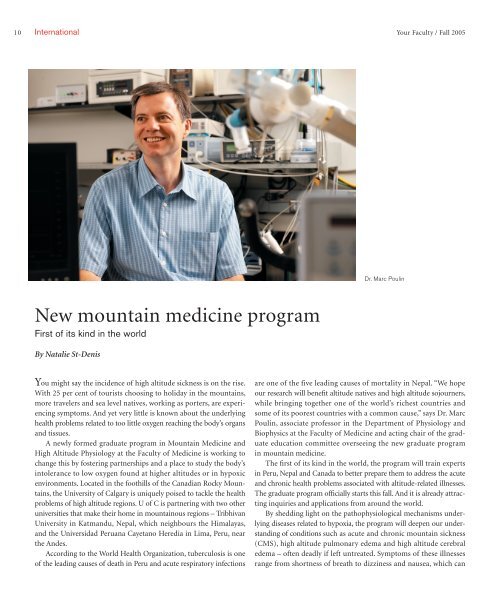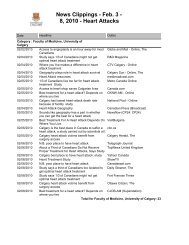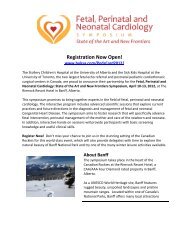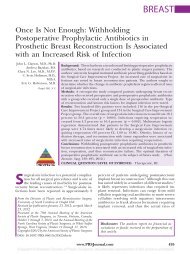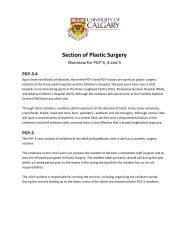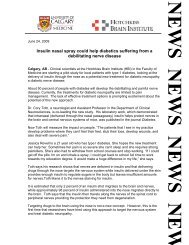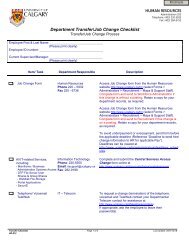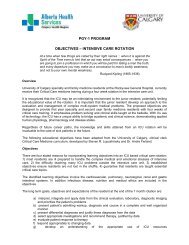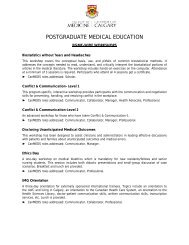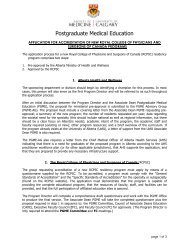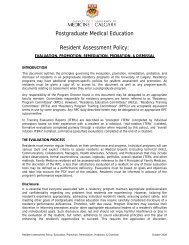Your Faculty / Fall 2005 - Faculty of Medicine - University of Calgary
Your Faculty / Fall 2005 - Faculty of Medicine - University of Calgary
Your Faculty / Fall 2005 - Faculty of Medicine - University of Calgary
You also want an ePaper? Increase the reach of your titles
YUMPU automatically turns print PDFs into web optimized ePapers that Google loves.
10 International<br />
<strong>Your</strong> <strong>Faculty</strong> / <strong>Fall</strong> <strong>2005</strong><br />
Dr. Marc Poulin<br />
New mountain medicine program<br />
First <strong>of</strong> its kind in the world<br />
By Natalie St-Denis<br />
Y<br />
ou might say the incidence <strong>of</strong> high altitude sickness is on the rise.<br />
With 25 per cent <strong>of</strong> tourists choosing to holiday in the mountains,<br />
more travelers and sea level natives, working as porters, are experiencing<br />
symptoms. And yet very little is known about the underlying<br />
health problems related to too little oxygen reaching the body’s organs<br />
and tissues.<br />
A newly formed graduate program in Mountain <strong>Medicine</strong> and<br />
High Altitude Physiology at the <strong>Faculty</strong> <strong>of</strong> <strong>Medicine</strong> is working to<br />
change this by fostering partnerships and a place to study the body’s<br />
intolerance to low oxygen found at higher altitudes or in hypoxic<br />
environments. Located in the foothills <strong>of</strong> the Canadian Rocky Mountains,<br />
the <strong>University</strong> <strong>of</strong> <strong>Calgary</strong> is uniquely poised to tackle the health<br />
problems <strong>of</strong> high altitude regions. U <strong>of</strong> C is partnering with two other<br />
universities that make their home in mountainous regions – Tribhivan<br />
<strong>University</strong> in Katmandu, Nepal, which neighbours the Himalayas,<br />
and the Universidad Peruana Cayetano Heredia in Lima, Peru, near<br />
the Andes.<br />
According to the World Health Organization, tuberculosis is one<br />
<strong>of</strong> the leading causes <strong>of</strong> death in Peru and acute respiratory infections<br />
are one <strong>of</strong> the five leading causes <strong>of</strong> mortality in Nepal. “We hope<br />
our research will benefit altitude natives and high altitude sojourners,<br />
while bringing together one <strong>of</strong> the world’s richest countries and<br />
some <strong>of</strong> its poorest countries with a common cause,” says Dr. Marc<br />
Poulin, associate pr<strong>of</strong>essor in the Department <strong>of</strong> Physiology and<br />
Biophysics at the <strong>Faculty</strong> <strong>of</strong> <strong>Medicine</strong> and acting chair <strong>of</strong> the graduate<br />
education committee overseeing the new graduate program<br />
in mountain medicine.<br />
The first <strong>of</strong> its kind in the world, the program will train experts<br />
in Peru, Nepal and Canada to better prepare them to address the acute<br />
and chronic health problems associated with altitude-related illnesses.<br />
The graduate program <strong>of</strong>ficially starts this fall. And it is already attracting<br />
inquiries and applications from around the world.<br />
By shedding light on the pathophysiological mechanisms underlying<br />
diseases related to hypoxia, the program will deepen our understanding<br />
<strong>of</strong> conditions such as acute and chronic mountain sickness<br />
(CMS), high altitude pulmonary edema and high altitude cerebral<br />
edema – <strong>of</strong>ten deadly if left untreated. Symptoms <strong>of</strong> these illnesses<br />
range from shortness <strong>of</strong> breath to dizziness and nausea, which can


